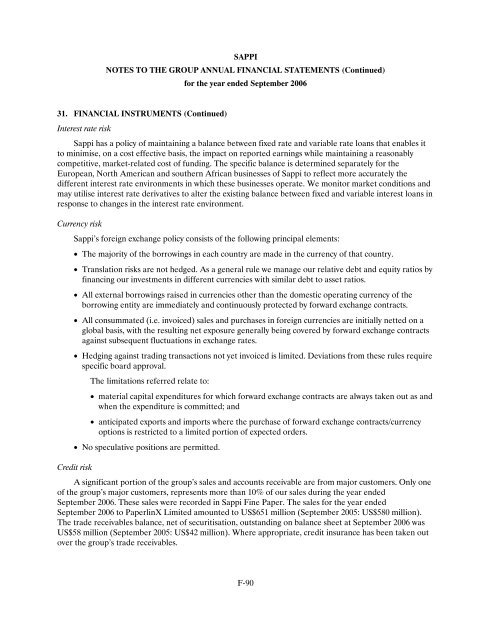You also want an ePaper? Increase the reach of your titles
YUMPU automatically turns print PDFs into web optimized ePapers that Google loves.
SAPPI<br />
NOTES TO THE GROUP ANNUAL FINANCIAL STATEMENTS (Continued)<br />
for the year ended September <strong><strong>20</strong>06</strong><br />
31. FINANCIAL INSTRUMENTS (Continued)<br />
Interest rate risk<br />
<strong>Sappi</strong> has a policy of maintaining a balance between fixed rate and variable rate loans that enables it<br />
to minimise, on a cost effective basis, the impact on reported earnings while maintaining a reasonably<br />
competitive, market-related cost of funding. The specific balance is determined separately for the<br />
European, North American and southern African businesses of <strong>Sappi</strong> to reflect more accurately the<br />
different interest rate environments in which these businesses operate. We monitor market conditions and<br />
may utilise interest rate derivatives to alter the existing balance between fixed and variable interest loans in<br />
response to changes in the interest rate environment.<br />
Currency risk<br />
<strong>Sappi</strong>’s foreign exchange policy consists of the following principal elements:<br />
• The majority of the borrowings in each country are made in the currency of that country.<br />
• Translation risks are not hedged. As a general rule we manage our relative debt and equity ratios by<br />
financing our investments in different currencies with similar debt to asset ratios.<br />
• All external borrowings raised in currencies other than the domestic operating currency of the<br />
borrowing entity are immediately and continuously protected by forward exchange contracts.<br />
• All consummated (i.e. invoiced) sales and purchases in foreign currencies are initially netted on a<br />
global basis, with the resulting net exposure generally being covered by forward exchange contracts<br />
against subsequent fluctuations in exchange rates.<br />
• Hedging against trading transactions not yet invoiced is limited. Deviations from these rules require<br />
specific board approval.<br />
The limitations referred relate to:<br />
• material capital expenditures for which forward exchange contracts are always taken out as and<br />
when the expenditure is committed; and<br />
• anticipated exports and imports where the purchase of forward exchange contracts/currency<br />
options is restricted to a limited portion of expected orders.<br />
• No speculative positions are permitted.<br />
Credit risk<br />
A significant portion of the group’s sales and accounts receivable are from major customers. Only one<br />
of the group’s major customers, represents more than 10% of our sales during the year ended<br />
September <strong><strong>20</strong>06</strong>. These sales were recorded in <strong>Sappi</strong> Fine Paper. The sales for the year ended<br />
September <strong><strong>20</strong>06</strong> to PaperlinX Limited amounted to US$651 million (September <strong>20</strong>05: US$580 million).<br />
The trade receivables balance, net of securitisation, outstanding on balance sheet at September <strong><strong>20</strong>06</strong> was<br />
US$58 million (September <strong>20</strong>05: US$42 million). Where appropriate, credit insurance has been taken out<br />
over the group’s trade receivables.<br />
F-90
















